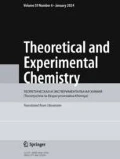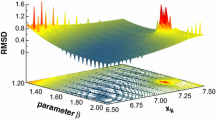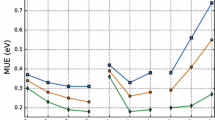Abstract
The multiconfiguration Hartree-Fock method (MC SCF) is examined for a superposition of a reference determinant ¦φ> containing all singly and doubly excited configurations. The gradients of the energy functional have been calculated for the singlet states. Pulay's method has been used in identifying the minimum. Calculations on the ground term A1 and excited term B1 for H2O in various bases indicate that the MC SCF procedure of the type considered is the most important when the contribution from ¦φ> is predominant. A realization is given for the superoperator configuration-interaction algorithm, which enables one to use an ES-1035 computer to calculate the ground state of the water-molecule dimer with 38,700 configurations.
Similar content being viewed by others
Literature cited
H.-J. Werner and E.-A. Reinsch, “Internally contracted MC SCF-SCEP calculations,” Adv. Theor. and Comput. Approach. Electron. Struct. Molecules: Proceedings of NATO Adv. Res. Workshop, Colorado Springs, September 25–29, 1983, Dordrecht (1984), pp. 79–105.
R. McWeeny, “Some remarks on multiconfiguration time-dependent Hartree-Fock theory,” Int. J. Quant. Chem., 23, No. 2, 405–416 (1983).
Yu. Yu. Dmitriev and A. V. Titov, “Brillouin's general theorem and the self-consistent approximation for transitional density matrices,” Vestn. Leningr. Univ., Ser. Fiz., No. 18, 15–21 (1985).
Ya. I. Frenkel', Wave Mechanics [in Russian], Gostekhizdat, Vol. 2, Leningrad (1934).
A. V. Luzanov and Yu. F. Pedash, “The superoperator method of calculating configuration interaction with the inclusion of all doubly excited configurations,” Teor. Eksp. Khim., 21, No. 4, 385–391 (1985).
B. Levy and G. Berthier, “Generalized Brillouin theorem for MC SCF theory,” Int. J. Quant. Chem., 2, No. 3, 307–319 (1968).
A. V. Luzanov, “The operator-reduction method in the theory of multielectron systems,” Fiz. Mol., No. 10, 65–96 (1981).
J. Olsen, P. Jorgensen, and D. Yeager, “Second and higher order convergence on linear and nonlinear multiconfigurational Hartree-Fock theory,” Int. J. Quant. Chem., 24, No. 1, 25–60 (1983).
P. Pulay, “Improved SCF convergence acceleration,” J. Comput. Chem., 3, No. 4, 556–560 (1982).
Reference Tables on Nuclear Geometrical Configurations and Internuclear Distances in Molecules and Ions in the Vapor State [in Russian], Izd. Standartov, Moscow (1982).
F. B. Brown, I. Shavitt, and R. Sheppard, “Multireference configuration interaction treatment of potential energy surfaces: symmetric dissociation of H2O in a doublezeta basis,” Chem. Phys. Lett., 105, No. 4, 363–369 (1984).
V. A. Kuprievich and V. E. Klimenko, “A computational scheme for optimizing multiconfiguration wave functions,” Teor. Eksp. Khim., 12, No. 2, 169–177 (1976).
V. A. Kuprievich, “Configuration differentiation and localization features of orbitals in multiconfiguration SCF theory,” Teor. Eksp. Khim., 18, No. 6, 648–653 (1982).
B. O. Roos and P. Siegbahn, “The direct configuration interaction method from molecular integrals,” Methods of Electronic Structure Theory, Plenum Press, New York (1977), pp. 277–318.
P. Siegbahn, “Generalizations of the direct CI method based on the graphical unitary group approach,” J. Chem. Phys., 70, No. 12, 5391–5397 (1979).
N. Handy, J. Goddard, and H. Shaeffer, “Generalization of the direct configuration interaction method to the Hartree-Fock interacting space for doublets, quartets and openshell singlets. Applications to NO2 and N2 −,” J. Chem. Phys., 71, No. 2, 426–438 (1979).
E. R. Davidson, “The iterative calculation of a few of the lowest eigenvalues of large matrices,” J. Comput. Phys., 17, No. 1, 87–94 (1975).
A. S. Zyubin, A. A. Gorbik, and O. P. Charkin, “Nonempirical calculations on the structures and relative stabilities of sodium hydrides with allowance for electron correlation,” Zh. Strukt. Khim., 26, No. 4, 37–41 (1985).
Author information
Authors and Affiliations
Additional information
Read at the Seventh All-Union Seminar on Nonempirical Computational Quantum Chemistry (Chernogolovka, 1985).
Translated from Teoreticheskaya i Éksperimental'naya Khimiya, Vol. 23, No. 1, pp. 1–10, January–February, 1987.
We are indebted to A. V. Nemukhin for discussion and advice.
Rights and permissions
About this article
Cite this article
Luzanov, A.V., Klimko, G.T. & Vul'fov, A.L. The multiconfiguration SCF method and large-scale configuration interaction in calculations for the A1 and B1 states of the water molecule. Theor Exp Chem 23, 1–9 (1987). https://doi.org/10.1007/BF00534969
Received:
Revised:
Issue Date:
DOI: https://doi.org/10.1007/BF00534969




